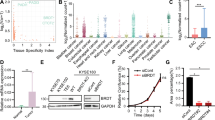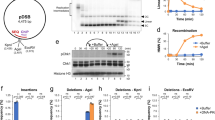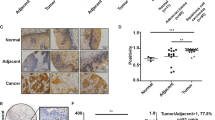Abstract
Bromodomain-containing protein 4 (BRD4) is an important epigenetic reader implicated in the pathogenesis of a number of different cancers and other diseases. Brd4-null mouse embryos die shortly after implantation and are compromised in their ability to maintain the inner cell mass, which gives rise to embryonic stem cells (ESCs). Here we report that BRD4 regulates expression of the pluripotency factor Nanog in mouse ESCs and preimplantation embryos, as well as in human ESCs and embryonic cancer stem cells. Inhibition of BRD4 function using a chemical inhibitor, small interfering RNAs, or a dominant-negative approach suppresses Nanog expression, and abolishes the self-renewal ability of ESCs. We also find that BRD4 associates with BRG1 (brahma-related gene 1, aka Smarca4 (SWI/SNF-related, matrix-associated, actin-dependent regulator of chromatin, subfamily a, member 4)), a key regulator of ESC self-renewal and pluripotency, in the Nanog regulatory regions to regulate Nanog expression. Our study identifies Nanog as a novel BRD4 target gene, providing new insights for the biological function of BRD4 in stem cells and mouse embryos. Knowledge gained from these non-cancerous systems will facilitate future investigations of how Brd4 dysfunction leads to cancers.
Similar content being viewed by others
Log in or create a free account to read this content
Gain free access to this article, as well as selected content from this journal and more on nature.com
or
Abbreviations
- Brd4:
-
bromodomain-containing protein 4
- ICM:
-
inner cell mass
- ESCs:
-
embryonic stem cells
- BET:
-
bromodomain and extraterminal protein
- LIF:
-
leukemia inhibitory factor
- BMP4:
-
bone morphogenetic protein 4
- AP:
-
alkaline phosphatase
- siRNAs:
-
small interfering RNAs
- BDI/II:
-
double bromodomains
- ChIP:
-
chromatin immunoprecipitation
- BRG1:
-
brahma-related gene 1, aka Smarca4 (SWI/SNF-related, matrix-associated, actin-dependent regulator of chromatin, subfamily a, member 4)
- ChIP-reChIP:
-
sequential ChIP analysis
- H3K27me3:
-
trimethylation of Lys27 of histone 3
- FBS:
-
fetal calf serum
- GV:
-
germinal vesicle
- MII:
-
metaphase II
- PVP:
-
polyvinylpyrrolidone
- KSOM+AA:
-
KSOM medium containing amino acids
- RA:
-
retinoic acid
References
Dey A, Ellenberg J, Farina A, Coleman AE, Maruyama T, Sciortino S et al. A bromodomain protein, MCAP, associates with mitotic chromosomes and affects G(2)-to-M transition. Mol Cell Biol 2000; 20: 6537–6549.
Wu SY, Chiang CM . The double bromodomain-containing chromatin adaptor Brd4 and transcriptional regulation. J Biol Chem 2007; 282: 13141–13145.
Loven J, Hoke HA, Lin CY, Lau A, Orlando DA, Vakoc CR et al. Selective inhibition of tumor oncogenes by disruption of super-enhancers. Cell 2013; 153: 320–334.
Zuber J, Shi J, Wang E, Rappaport AR, Herrmann H, Sison EA et al. RNAi screen identifies Brd4 as a therapeutic target in acute myeloid leukaemia. Nature 2011; 478: 524–528.
Rodriguez RM, Huidobro C, Urdinguio RG, Mangas C, Soldevilla B, Dominguez G et al. Aberrant epigenetic regulation of bromodomain BRD4 in human colon cancer. J Mol Med (Berl) 2012; 90: 587–595.
Filippakopoulos P, Qi J, Picaud S, Shen Y, Smith WB, Fedorov O et al. Selective inhibition of BET bromodomains. Nature 2010; 468: 1067–1073.
Crawford NP, Alsarraj J, Lukes L, Walker RC, Officewala JS, Yang HH et al. Bromodomain 4 activation predicts breast cancer survival. Proc Natl Acad Sci USA 2008; 105: 6380–6385.
French CA, Miyoshi I, Aster JC, Kubonishi I, Kroll TG, Dal Cin P et al. BRD4 bromodomain gene rearrangement in aggressive carcinoma with translocation t(15;19). Am J Pathol 2001; 159: 1987–1992.
Hnisz D, Abraham BJ, Lee TI, Lau A, Saint-Andre V, Sigova AA et al. Super-Enhancers in the Control of Cell Identity and Disease. Cell 2013; 155: 934–947.
Houzelstein D, Bullock SL, Lynch DE, Grigorieva EF, Wilson VA, Beddington RS . Growth and early postimplantation defects in mice deficient for the bromodomain-containing protein Brd4. Mol Cell Biol 2002; 22: 3794–3802.
Nishiyama A, Dey A, Miyazaki J, Ozato K . Brd4 is required for recovery from antimicrotubule drug-induced mitotic arrest: preservation of acetylated chromatin. Mol Biol Cell 2006; 17: 814–823.
Boyer LA, Lee TI, Cole MF, Johnstone SE, Levine SS, Zucker JP et al. Core transcriptional regulatory circuitry in human embryonic stem cells. Cell 2005; 122: 947–956.
Young RA . Control of the embryonic stem cell state. Cell 2011; 144: 940–954.
Silva J, Nichols J, Theunissen TW, Guo G, van Oosten AL, Barrandon O et al. Nanog is the gateway to the pluripotent ground state. Cell 2009; 138: 722–737.
Mitsui K, Tokuzawa Y, Itoh H, Segawa K, Murakami M, Takahashi K et al. The homeoprotein Nanog is required for maintenance of pluripotency in mouse epiblast and ES cells. Cell 2003; 113: 631–642.
Chambers I, Silva J, Colby D, Nichols J, Nijmeijer B, Robertson M et al. Nanog safeguards pluripotency and mediates germline development. Nature 2007; 450: 1230–1234.
Ivanova N, Dobrin R, Lu R, Kotenko I, Levorse J, DeCoste C et al. Dissecting self-renewal in stem cells with RNA interference. Nature 2006; 442: 533–538.
Nichols J, Zevnik B, Anastassiadis K, Niwa H, Klewe-Nebenius D, Chambers I et al. Formation of pluripotent stem cells in the mammalian embryo depends on the POU transcription factor Oct4. Cell 1998; 95: 379–391.
Do DV, Ueda J, Messerschmidt DM, Lorthongpanich C, Zhou Y, Feng B et al. A genetic and developmental pathway from STAT3 to the OCT4-NANOG circuit is essential for maintenance of ICM lineages in vivo. Genes Dev 2013; 27: 1378–1390.
Davis AC, Wims M, Spotts GD, Hann SR, Bradley A . A null c-myc mutation causes lethality before 10.5 days of gestation in homozygotes and reduced fertility in heterozygous female mice. Genes Dev 1993; 7: 671–682.
Nishiyama A, Sharov AA, Piao Y, Amano M, Amano T, Hoang HG et al. Systematic repression of transcription factors reveals limited patterns of gene expression changes in ES cells. Sci Rep 2013; 3: 1390.
Wang R, Li Q, Helfer CM, Jiao J, You J . Bromodomain protein Brd4 associated with acetylated chromatin is important for maintenance of higher-order chromatin structure. J Biol Chem 2012; 287: 10738–10752.
Miyanari Y, Torres-Padilla ME . Control of ground-state pluripotency by allelic regulation of Nanog. Nature 2012; 483: 470–473.
Nagashima T, Maruyama T, Furuya M, Kajitani T, Uchida H, Masuda H et al. Histone acetylation and subcellular localization of chromosomal protein BRD4 during mouse oocyte meiosis and mitosis. Mol Hum Reprod 2007; 13: 141–148.
Yan J, Diaz J, Jiao J, Wang R, You J . Perturbation of BRD4 protein function by BRD4-NUT protein abrogates cellular differentiation in NUT midline carcinoma. J Biol Chem 2011; 286: 27663–27675.
Jiang J, Chan YS, Loh YH, Cai J, Tong GQ, Lim CA et al. A core Klf circuitry regulates self-renewal of embryonic stem cells. Nat Cell Biol 2008; 10: 353–360.
Kuroda T, Tada M, Kubota H, Kimura H, Hatano SY, Suemori H et al. Octamer and Sox elements are required for transcriptional cis regulation of Nanog gene expression. Mol Cell Biol 2005; 25: 2475–2485.
Rodda DJ, Chew JL, Lim LH, Loh YH, Wang B, Ng HH et al. Transcriptional regulation of nanog by OCT4 and SOX2. J Biol Chem 2005; 280: 24731–24737.
Ito S, D'Alessio AC, Taranova OV, Hong K, Sowers LC, Zhang Y . Role of Tet proteins in 5mC to 5hmC conversion, ES-cell self-renewal and inner cell mass specification. Nature 2010; 466: 1129–1133.
Ho L, Miller EL, Ronan JL, Ho WQ, Jothi R, Crabtree GR . esBAF facilitates pluripotency by conditioning the genome for LIF/STAT3 signalling and by regulating polycomb function. Nat Cell Biol 2011; 13: 903–913.
Kidder BL, Palmer S, Knott JG . SWI/SNF-Brg1 regulates self-renewal and occupies core pluripotency-related genes in embryonic stem cells. Stem Cells 2009; 27: 317–328.
Jeter CR, Badeaux M, Choy G, Chandra D, Patrawala L, Liu C et al. Functional evidence that the self-renewal gene NANOG regulates human tumor development. Stem Cells 2009; 27: 993–1005.
Reya T, Morrison SJ, Clarke MF, Weissman IL . Stem cells, cancer, and cancer stem cells. Nature 2001; 414: 105–111.
Ben-Porath I, Thomson MW, Carey VJ, Ge R, Bell GW, Regev A et al. An embryonic stem cell-like gene expression signature in poorly differentiated aggressive human tumors. Nat Genet 2008; 40: 499–507.
Whyte WA, Orlando DA, Hnisz D, Abraham BJ, Lin CY, Kagey MH et al. Master transcription factors and mediator establish super-enhancers at key cell identity genes. Cell 2013; 153: 307–319.
Kadoch C, Hargreaves DC, Hodges C, Elias L, Ho L, Ranish J et al. Proteomic and bioinformatic analysis of mammalian SWI/SNF complexes identifies extensive roles in human malignancy. Nat Genet 2013; 45: 592–601.
Ying QL, Nichols J, Chambers I, Smith A . BMP induction of Id proteins suppresses differentiation and sustains embryonic stem cell self-renewal in collaboration with STAT3. Cell 2003; 115: 281–292.
Thomson M, Liu SJ, Zou LN, Smith Z, Meissner A, Ramanathan S . Pluripotency factors in embryonic stem cells regulate differentiation into germ layers. Cell 2011; 145: 875–889.
Ying QL, Wray J, Nichols J, Batlle-Morera L, Doble B, Woodgett J et al. The ground state of embryonic stem cell self-renewal. Nature 2008; 453: 519–523.
Ying QL, Smith AG . Defined conditions for neural commitment and differentiation. Methods Enzymol 2003; 365: 327–341.
You J, Croyle JL, Nishimura A, Ozato K, Howley PM . Interaction of the bovine papillomavirus E2 protein with Brd4 tethers the viral DNA to host mitotic chromosomes. Cell 2004; 117: 349–360.
Boyd KE, Wells J, Gutman J, Bartley SM, Farnham PJ . c-Myc target gene specificity is determined by a post-DNAbinding mechanism. Proc Natl Acad Sci USA 1998; 95: 13887–13892.
Boyd KE, Farnham PJ . Myc versus USF: discrimination at the cad gene is determined by core promoter elements. Mol Cell Biol 1997; 17: 2529–2537.
Ho Y, Wigglesworth K, Eppig JJ, Schultz RM . Preimplantation development of mouse embryos in KSOM: augmentation by amino acids and analysis of gene expression. Mol Reprod Dev 1995; 41: 232–238.
Kurasawa S, Schultz RM, Kopf GS . Egg-induced modifications of the zona pellucida of mouse eggs: effects of microinjected inositol 1,4,5-trisphosphate. Dev Biol 1989; 133: 295–304.
Anger M, Stein P, Schultz RM . CDC6 requirement for spindle formation during maturation of mouse oocytes. Biol Reprod 2005; 72: 188–194.
Acknowledgements
We thank M Celeste Simon (University of Pennsylvania) for P19 cells, Mitchell J Weiss (The Children’s Hospital of Philadelphia) for R1 cells, James E Bradner (Dana-Farber Cancer Institute) for JQ1, Weidong Wang (NIH) for Brg1 antibody and Jing Jiao for technical support. We thank members of our laboratories for helpful discussion and critical review of the manuscript. This work has been supported by NIH grants R01CA148768 and R01CA142723 to JY and R01HD022681 to RMS.
Author information
Authors and Affiliations
Corresponding author
Ethics declarations
Competing interests
The authors declare no conflict of interest.
Additional information
Edited by D Vaux
Supplementary Information accompanies this paper on Cell Death and Differentiation website
Supplementary information
Rights and permissions
About this article
Cite this article
Liu, W., Stein, P., Cheng, X. et al. BRD4 regulates Nanog expression in mouse embryonic stem cells and preimplantation embryos. Cell Death Differ 21, 1950–1960 (2014). https://doi.org/10.1038/cdd.2014.124
Received:
Revised:
Accepted:
Published:
Issue date:
DOI: https://doi.org/10.1038/cdd.2014.124
This article is cited by
-
Znf687 recruits Brd4-Smrt complex to regulate gfi1aa during neutrophil development
Leukemia (2024)
-
The Beneficial Effects of Static Magnetic Field and Iron Oxide Nanoparticles on the Vitrification of Mature Mice Oocytes
Reproductive Sciences (2023)
-
BET proteins are essential for the specification and maintenance of the epiblast lineage in mouse preimplantation embryos
BMC Biology (2022)
-
Differential transcriptional regulation of the NANOG gene in chicken primordial germ cells and embryonic stem cells
Journal of Animal Science and Biotechnology (2021)
-
NR5A2 transcriptional activation by BRD4 promotes pancreatic cancer progression by upregulating GDF15
Cell Death Discovery (2021)



